The Sultan Abdul Samad Building - An iconic landmark that has stood the test of time
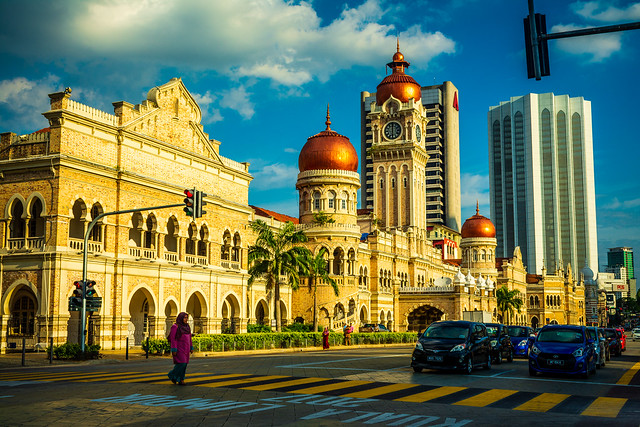 |
| The Sultan Abdul Samad Building bathed in the warm late evening sunlight |
INTRODUCTION
The most prominent heritage building in Kuala Lumpur is none other than the Sultan Abdul Samad Building (Bangunan Sultan Abdul Samad in Malay). The majestic building, built between 1894 and 1897, was the best known landmark of Malaysia until the Petronas Twin Towers were built and still today is one of the most photographed buildings in Malaysia.
Located opposite the Padang (now Independence Square) in the heart of Kuala Lumpur, the Sultan Abdul Samad Building has become synonymous with Kuala Lumpur, attracting local and foreign tourists as well as the heritage building buffs thanks to its immense architectural, historical and cultural significance.
The building has been accorded the status it well deserved when it was listed as one of the National Heritage in 2007 under the National Heritage Act 2005. It has been standing the test of time for more than a century (117 years to be exact) without any substantial structural alterations.
 | |
|
HISTORICAL BACKGROUND
The Selangor State Government moved its administrative headquarters from Klang to the more developed area, Kuala Lumpur in 1880 after obtaining the consent from the reigning Sultan of Selangor, Sultan Sir Abdul Samad ibni Almarhum Raja Abdullah (1804 – 1898). Kuala Lumpur until then was merely a mining and trading settlement. The first government offices were built on the high ground in Bluff Road area (the present Bukit Aman) overlooking what is now Merdeka Square on its west side. In 1882, Frank Swettenham took over as the Resident of Selangor and he began replacing and adding to the government offices in Bluff Road area. The expansion was limited though due to the budget constraint.
When W. E. Maxwell became the Resident of Selangor in 1889, after building two new hospitals to meet the health needs of the growing population, he started to plan the construction of the new government offices as he realised the government under his leadership was in urgent need of bigger offices. He envisioned the premise that would house all the offices under one central office complex. However he was mindful of the limitations of the Public Works Department (PWD) under H.F. Bellamy, a civil engineer, and A.C. Norman, an architect. Both Bellamy and Norman were said to have been lacking in talent and drive to execute a major construction programme despite them being professionally qualified.
Maxwell brought in C.E. Spooner who worked in Ceylon to overhaul the Selangor PWD which resulted in Spooner’s permanent transfer to Selangor, where he remained until his death in 1907. Spooner was appointed as State Engineer and his first task was to reorganise the methods and in particular the procurement of supplies of the PWD. Spooner proved to be more competent when he quickly established a PWD ‘Factory’ in Brickfields to produce bricks, tiles, sawn timber and some metal products in larger quantity, better quality and at lower cost than the supplies previously obtained from local contractors. These improvements were an essential preparation for the building programme.
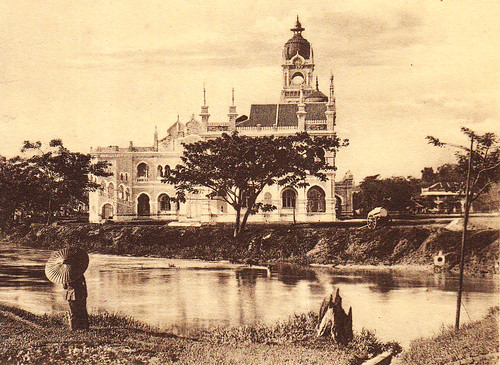 |
| The Sultan Abdul Samad Building is near completion viewed from across the Klang River c 1897. Notice the clock tower is not installed with the clock yet. Picture source: skyscrapercity.com forum |
The foundation stone of the Sultan Abdul Samad Building was laid by H.E. Sir Charles B.H. Mitchell K.C.M.G. (The Governor of Straits Settlements) on 6 October 1894 to officially commence the construction work. The whole project was supervised by Spooner as the State Engineer and the Director of Public Works Department.
Its construction was considered a ‘megaproject’ back then. The construction of the building absorbed 4 million bricks, 2,500 barrel of cement, 18,000 pikuls of lime, 5,000 pounds of copper, 50 tons of steel and iron and about 3,000 cubic feet of timber. In structural term the building itself was a bold experiment and it was the climax of the late 19th century buildings in Kuala Lumpur. Although there was some concern in the beginning about the risk of erecting ‘such a huge’ building so close to the bank of the Klang River and the doubt about the strength of the ‘massive’ clock tower standing at 135 feet high, Spooner was competent enough to make many alterations and additions as the work progressed including further strengthening the structure. Not only did he manage to prove his sceptics wrong but also complete the building on time at the cost provided in his original estimate. In fact the entire structure survived intact and stands proudly 117 years after it was built.
The construction project took 2 years and 7 months to complete. The Building was completed in 1897 at a cost of 152,000.00 Straits Dollars to house the government of the Federated Malay States and the government of Selangor. It was officially opened by Sir Frank Swettenham K.C.M.G. (the Resident-General of the Federated Malay States) on 4 April 1897. It was said the opening ceremony was a grand affair where the PWD dinner was held in the newly completed building and the important guests were invited from all over Malaya. In addition to the opening ceremony there was a ball in the building itself, lit by electricity and handsomely decorated while gas burners floodlit the exterior. It was the first instance of such illumination in Kuala Lumpur which was considered a backwater earlier compared to more advanced Singapore at that time.
ARCHITECTURAL FEATURES
According to an article titled The Bangunan Sultan Abdul Samad by J.M. Gullick in Journal of the Malaysian Brand of the Royal Asiatic Society Vol. 65. The State Engineer, C.E. Spooner did not like the original plan of Classic Renaissance for the building as drawn out and proposed by A.C. Norman, the Government Architect. Instead C.E. Spooner decided on the architecture of his own design and it was what he called "Mahometan" (sic) style.
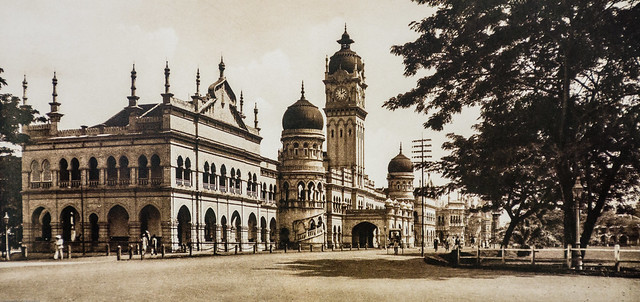 |
| Sultan Abdul Samad Building c.1920.Image reproduced from "Malaysia: A Pictorial History 1400-2004" book by Wendy Khadijah Moore without permission but in accordance with the principle of fair use. |
There was no explanation by Spooner on his decision to build in the Mahometan style but there can be no doubt that he adopted as a model a style which British architects had evolved for public buildings in British India in the late 19th century. The style normally was referred to as neo-Saracenic, Indo-Saracenic or Neo-Mughal. The Mahometan style on Spooner’s term was eclectic, being a combination of ‘an Egyptian phase of Muslim architecture’ with the Saracenic style of Indian buildings and even elements of ‘a Western Gothic design’. The aesthetic qualities in the eclectic style with obvious Islamic style appealed to Spooner and appeared to be more suitable for the principal offices of a Malay State Government than the English town hall mock Greek temple originally proposed to him.
Although the decision on the ‘Mahometan style’ was made by Spooner, the details of the design and drawings were done by R.A.J Bidwell, a 24-year-old assistant architect under the supervision of A.C. Norman and Spooner himself who continued to make many alterations and additions even during construction. Arthur Benison Hubback (responsible for the design of many Mughal style buildings in Malaya later) who had just joined the government service in Malaya as a senior draughtsman was also mentioned by Spooner to have rendered him valuable assistance in alterations and additions to the design as well as in the designing of the fixtures.
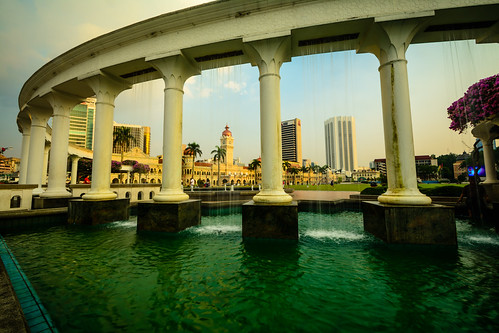 | |
|
The two-storey building, built in the shape of the letter F for its floor plan, occupies a ground area of 4,208.5 square metres (45,300 sq ft) while its front façade stretches 450 feet (137.2m) along Jalan Raja (formerly Gombak Road) while its tallest structure, the clock tower, stands at 135 feet (41m high) above street level. The 41m clock tower is flanked by two circular but lower towers both of which contain large stairways leading to the first floor. All towers have onion-shaped domes with copper coverings.
The most prominent feature of the whole building is certainly the immense clock tower standing at the centre of the building at a height of 135ft (41m) above street level. The clock tower houses a one-ton bell clock striking the hours and half hours, while having a four-sided opal glass dial 8 ½ ft in diameter. The clock was imported from South Croydon, Surrey in England and manufactured by Gillett & Johnston (Croydon) Ltd. The clock tower was built with the purpose of replicating the famous Big Ben of London. Its clock chimed for the first time in 1897 to coincide with Queen Victoria’s Diamond Jubilee parade.
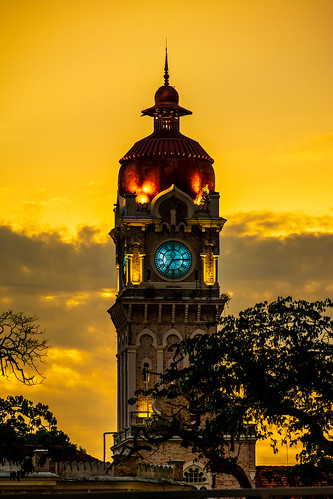 | |
|
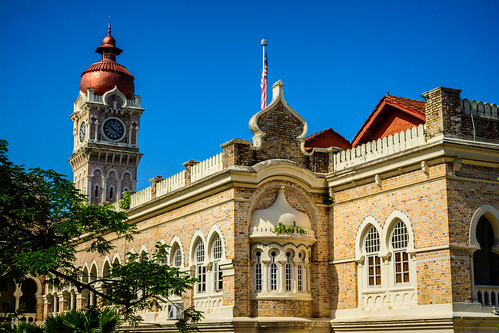 |
| At the back of the Sultan Abdul Samad Building |
FUNCTIONS & EVENTS
Upon completion in 1897, the Building was simply known as the Government Offices. The Building was shared by the Government of the Federated Malay States and the Selangor State Government comprising various offices including Government Secretariat Office, State Council Chamber, Post Office, Sanitary Board, Judicial Commissioner, Public Work Department, the Accountant General office, the Marriage Registry Office and District Office.
When the Federation of Malaya was formed in 1948, the Building was renamed as the Federal Secretariat. The building still retained its function after the independence of Malaya in 1957 and the formation of Malaysia in 1963. In 1971 Kuala Lumpur was hit by a major flood which was considered to be the worst flood in Kuala Lumpur history whilst poor drainage system at that time exacerbated the catastrophe. The Sultan Abdul Samad Building was not spared as some parts of the building were damaged.
It was until 1974 when all of the State of Selangor Government offices were relocated to Shah Alam and The Federal Government also moved its office to a new building in Jalan Duta, for the first time, the Building was renamed Bangunan Sultan Abdul Samad. It was named in honour of Sultan Sir Abdul Samad ibni Almarhum Raja Abdullah (1804 – 1898) who was the Sultan of Selangor from 1857 till 1898 during which the building was completed.
A major renovation work was undertaken in 1978 which took 6 years to complete with an expense of RM 17.2 million. The Supreme Court (now Federal Court), Appeal Court and Malaya High Court were moved here in stages beginning from 1978. This classic Building has played host to the three main courts of Malaysia for many years. In fact this Building used to become the icon of the Malaysian Court of Law when some high profile cases were tried here and the Building became the centre of attention worldwide. Little wonder it was chosen to appear as the site of the Malaysian court in a 1992 Hong Kong box office movie titled Police Story 3: Super Cop starring Jackie Chan and Michelle Yeoh.
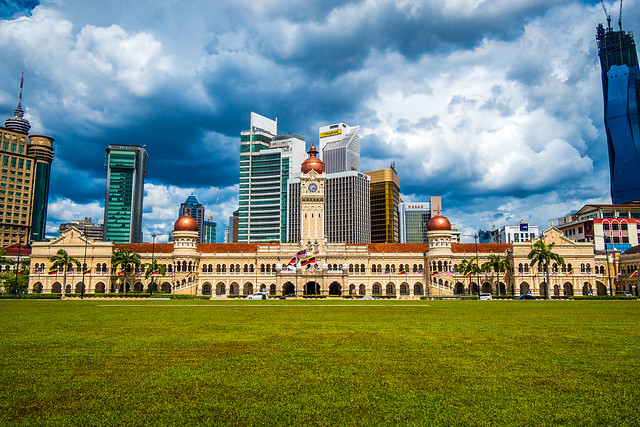 |
| The Sultan Abdul Samad Building and the Padang (now The Independence Square) |
In 2000 The Federal Court and the Appeal Court were relocated again to the new and bigger Palace of Justice in Putrajaya while the High Court was moved to a new court complex in Jalan Duta in 2007. The Ministry of Information. Communications and Culture took over the Building in the same year after which it underwent another restoration process of its façade at a cost of RM2.37 million carried out by the Department of National Heritage from 17 August 2009 until 16 April 2010.
In its 117-year history The Sultan Abdul Samad Building has witnessed many historic events taking place right in front of it. It was here, the Union Jack flag was lowered and the Malayan flag hoisted for the first time at midnight on August 31, 1957 when the country’s independence was pronounced by the Malaysian first prime minister, Tunku Abdul Rahman Putra. The Building also witnessed the historic standardization of Peninsula Malaysia, Sabah and Sarawak time to +8 GMT inaugurated by the then new prime minister, Dato’ Seri Dr. Mahathir Mohamed in 1982. Meanwhile on 1 January 1990, The Dataran Merdeka, formerly known as the Selangor Club Padang, located opposite the Building was officially opened in conjunction with Visit Malaysia Year 1990.
The Sultan Abdul Samad Building, while its architectural style is not particularly Malaysian and would look more at home in India, has come to symbolize Malaysia with its multi-racial and multi-cultural societies and has played an important role in the country’s history. Although the British Colonial Government has long gone more than 57 years ago from Malaya the structure will still remain for so many years to come as part of the national history and identity. Additionally it is the precious national heritage for the newer generations to study and treasure. It is fervently hoped that the government through its relevant authorities will spare no efforts in preserving not only this particular Building but also other heritage buildings all over the country as they said “a city without old buildings is like a man without memory”.
 |
| Viewed from behind the Royal Selangor Club |
 |
| The garlic-shaped finials that adorn the imposing porch |
[Updated on 30 Dec 2021]
REFERENCES:
A Ghafar Ahmad, (2011). Restoration of building façade at the Sultan Abdul Samad Building, Kuala Lumpur, Malaysia. The Eighth Regular Report, ACCU Nara International Correspondent, 17-19.
A Ghafar Ahmad, (1997). Chronological biography of Arthur Charles Alfred Norman. Journal of the Malaysian Branch of the Royal Asiatic Society, 70, 21-29.
Gibson, M. (2009, March-April). When the Sultan Abdul Samad Building was new. Bulletin Warisan, 3-4.
Gullick, J.M. (1992). The Bangunan Sultan Abdul Samad. Journal of the Malaysian Branch of the Royal Asiatic Society, 65, 27-38.
Informative Blog
ReplyDeleteVisit Us
luxury home construction builders in burnaby
Informative Blog
ReplyDeleteVisit Us
building contractors in Surrey
Tthanks a lot for sharing with us. I am glad to read your post about iconic buildings, specially the sultan samad. Nice job. biesterbosgroep.nl
ReplyDeleteNice Blog
ReplyDeleteThanks for sharing
Visit Us
Best house building companies Langley
best custom home building company Langley
Custom homes in West Langley
Best custom home designs Langley
premium building Surrey
custom home contractors in surrey
Best building contractors in Langley
Best construction companies Surrey
Complete drywall services in Langley
Home consultations in Surrey
luxury dream home builds
custom home builder in surrey
custom home builder in langley
custom home contractors in langley
Townhouse Builders in Surrey
High End Build Homes Surrey
apartment builders in langley
building contractors in Surrey
drywall services Surrey
renovations service Surrey
best home building services
Home consultations in Surrey
unique custom homes
Complete building and renovation services
building and renovation services
Best construction companies Surrey
Nice post.
ReplyDeleteThanks for sharing.
Visit Western luxury.
Best house building companies Langley
best custom home building company Langley
Custom homes in West Langley
Best custom home designs Langley
premium building Surrey
custom home contractors in surrey
Best building contractors in Langley
Best construction companies Surrey
Complete drywall services in Langley
Home consultations in Surrey
luxury dream home builds
custom home builder in surrey
custom home builder in langley
custom home contractors in langley
Townhouse Builders in Surrey
High End Build Homes Surrey
apartment builders in langley
building contractors in Surrey
drywall services Surrey
renovations service Surrey
best home building services
Home consultations in Surrey
unique custom homes
Complete building and renovation services
building and renovation services
Best construction companies Surrey
Excellent article, Would love to know more about it.
ReplyDeleteCustom metal roofing in Surrey
Can you check my blog as well.
Thank you for visiting my blog and leaving a comment.
DeleteExcellent article, Would love to know more about it.
ReplyDeleteRoofing companies Langley
Can you check my blog as well.
Exciting
ReplyDeleteThank you for dropping by and leaving your comment.
DeleteHI Zain, where can I get a copy of Gibson, M. (2009, March-April). When the Sultan Abdul Samad Building was new. Bulletin Warisan, 3-4. ?
ReplyDelete